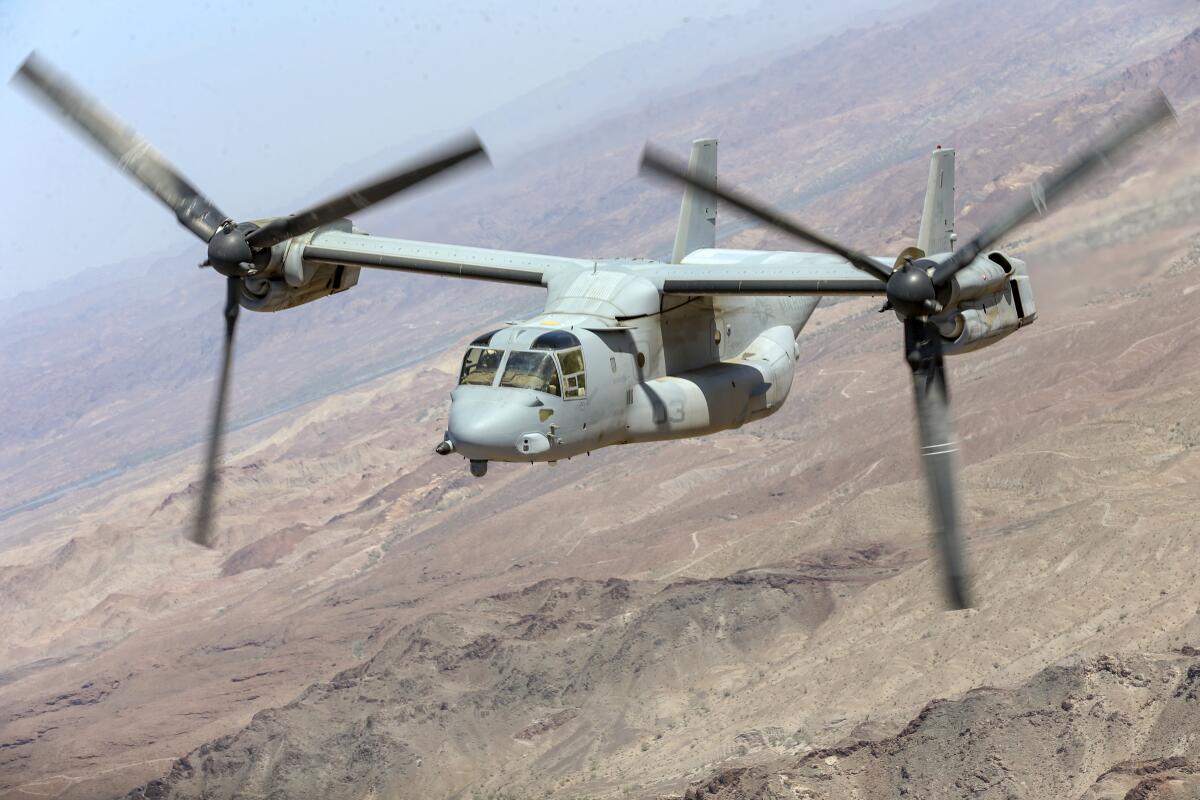All 5 Marines aboard Osprey aircraft died in crash in Imperial County, officials say

All five U.S. Marines aboard a military aircraft that crashed Wednesday afternoon in Imperial County were killed, officials said.
The MV-22B Osprey crashed during a training mission near Glamis, officials with the 3rd Marine Aircraft Wing said Thursday. Glamis is approximately 150 miles east of San Diego near the borders with Arizona and Mexico.
The names of the deceased Marines will not be released until after relatives are notified, according to military officials.
“We mourn the loss of our Marines in this tragic mishap,” Maj. Gen. Bradford J. Gering said in a statement. “Our hearts go out to their families and friends as they cope with this tragedy.”
The aircraft was based at Marine Corps Air Station Camp Pendleton with Marine Aircraft Group 39 and crashed around 12:25 p.m. near Coachella Canal Road and Highway 78. Contrary to reports on social media and early radio calls from the scene by emergency responders, there were no nuclear materials onboard, Cpl. Sarah Marshall, a spokesperson for the 3rd Marine Aircraft Wing, said Wednesday.
Military personnel are recovering debris from the crash and an investigation into the cause is underway.
The Osprey is a tilt-rotor aircraft that can take off and land like a helicopter and fly like an airplane by pivoting its rotors. Versions of the aircraft are flown by the Marines, Navy and Air Force to transport troops and equipment. It has a higher top speed and longer range than a helicopter but is able to hover and land in a similar manner.
The aircraft, however, has a troubled and controversial history since its first test flights in 1989.
Rex Rivolo, a former Air Force pilot and retired analyst with the the Institute for Defense Analyses, a Pentagon think tank, followed the V-22’s development from 1992 through 2009. Early on, he concluded that the aircraft’s complex design made it susceptible to uncontrolled rolling.
“Because of its complexity, it can be a very slippery,” Rivolo said when reached by phone Thursday.
Before it was officially introduced in 2007, the aircraft was involved in a crash that killed 19 Marines during a training exercise at Marana Northwest Regional Airport in Arizona on April 8, 2000.
Rivolo said that all aircraft have “flight envelopes,” their operational limits for airspeed and other factors. Most aircraft have about a dozen flight envelopes, parameters that pilots should not exceed to maintain control.
“The problem with the V-22 is it doesn’t have five or six envelopes. It’s got thousands of envelopes, because each different pitch of the cells has its own set of envelopes,” Rivolo said. “A small mistake in a typical helicopter just causes minor problems. Maybe it scares the pilot, but in a V-22 a minor mistake can kill you.”
In March, four North Carolina-based Marines died in another Osprey crash during a North Atlantic Treaty Organization exercise in Norway.
Wednesday’s fatalities added to the at least 46 deaths since the military began testing the unique aircraft, available records show. Since the Pentagon made it operational in 2007, there have been eight Osprey crashes.
After an Osprey crashed in the Arabian Sea in 2014, killing its crew chief, Marine Corps investigators concluded in a 183-page report that the aircraft was doomed before takeoff because it was accidentally started in maintenance mode.
During development and testing, the aircraft’s advocates argued that the Osprey would revolutionize warfare because of its tilt-rotor capabilities, but it became embroiled in scandal after a series of fatal crashes.
More to Read
Start your day right
Sign up for Essential California for news, features and recommendations from the L.A. Times and beyond in your inbox six days a week.
You may occasionally receive promotional content from the Los Angeles Times.






